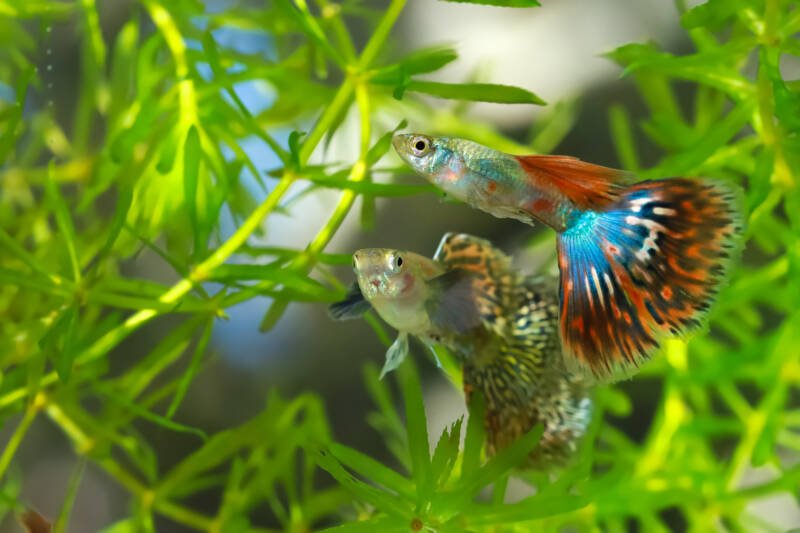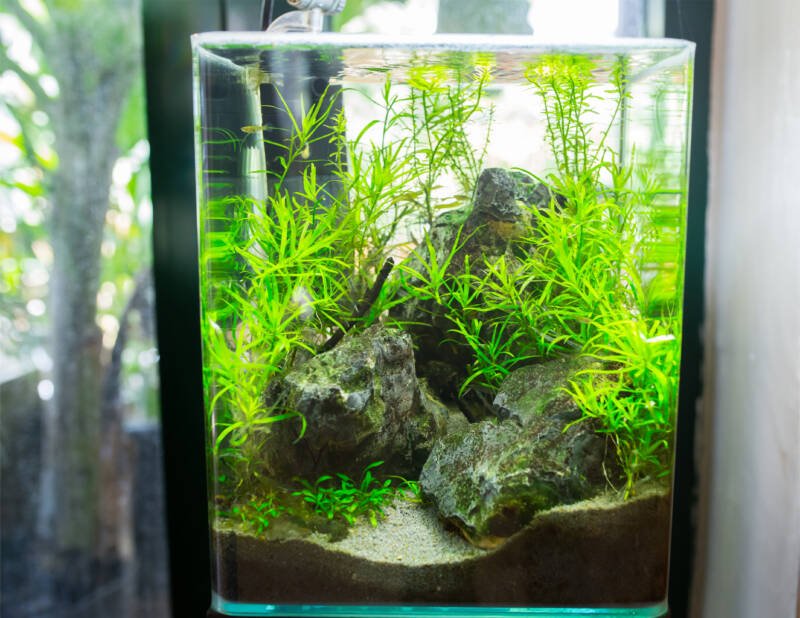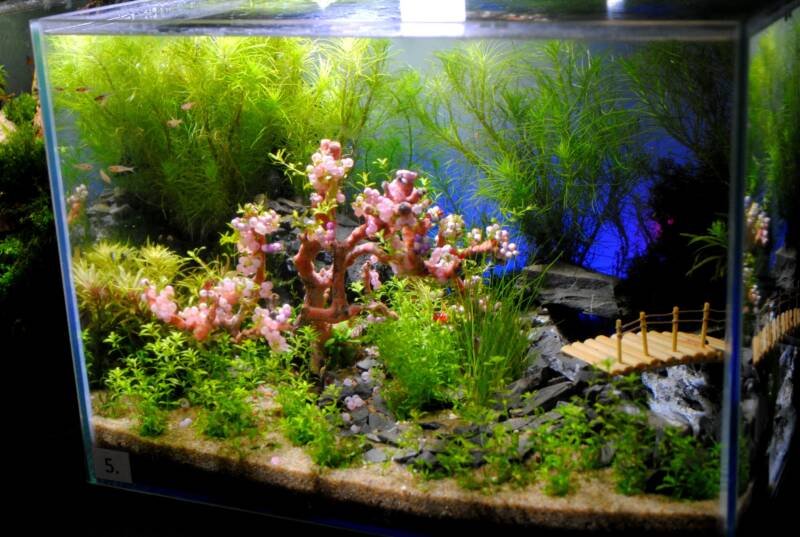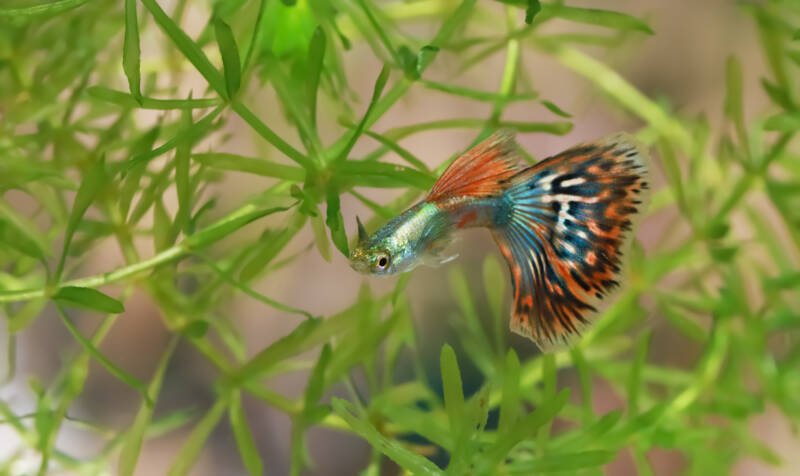Guppy grass (Naja guadalupensis) is a freshwater aquarium plant that has mixed reviews in the aquarium hobby. It is a well-known floating plant that is also known as najas grass or the common water nymph.
On the one hand, this easy-to-grow plant is amazing for breeders looking to provide food and shelter to fish fry.
On the flip-side, this fast grower has been known to outgrow its tank and smother some of the other more well-behaved plants.

Read on to decide whether it’s the right plant for your tank and learn everything you need to know about its growth and care.
At Glance
| Species: | Naja guadalupensis |
| Family: | Hydrocharitaceae |
| Tank size: | 15 gal (57 l) or more |
| Plant type: | floating plant |
| Lighting: | low-moderate |
| Water temperature: | 72-82°F (22-28°C) |
| pH: | 6-8 |
| Hardness: | 2-25 dKH |
| Propagation: | stem and side shoot division |
| Size: | 1-3 ft (30-90 cm) |
Natural Habitat
Guppy grass is a species of aquatic plant from the Hydrocharitaceae family. It has a wide distribution, and you can find it growing wild in North and South America, from Canada all the way to Argentina and Uruguay.
You’ll find guppy grass growing in still and flowing aquatic environments like streams and ponds within its natural habitat.
This fast-growing plant has become an invasive species in some parts of the world, including parts of Eastern Asia and the Middle East. It takes off very easily if introduced to local waterways, so you should always take care when disposing of trimmings.
Size & Description

Guppy grass is not actually grass at all. In fact, it is a green stem plant that can reach over 3 feet (90 cm) tall!
It has very fine, soft leaves that grow a little over an inch (2.5 cm) in length. Each leaf margin is lined with tiny structures known as unicellular teeth.
This plant has long white roots to add to the overall green color. These roots can grow into the substrate or simply hang in the water column.
Why Grow Guppy Grass
Guppy grass is super easy to grow, so if you’re looking to green up your aquarium fast, it could be a great choice.
This plant is a column feeder, which means it removes excess nutrients from the water. In this way, it turns harmful nutrients into even more green growth. What a bonus!
That’s not all that guppy grass can do for your tank, however. These plants also oxygenate the water naturally and outcompete pesky algae at the same time.
Where To Plant Guppy Grass

You can use guppy grass as an easy background plant, but it works best when allowed to float in the water column. You can even anchor the plant to the bottom with plant weights to keep it in place in bare bottom tanks.
It is not a very tidy plant, however, so be ready to trim it regularly. So it’s not the best aquascaping species, but what is it good for?

Guppy Grass For Breeders
Guppy grass is great for fish breeders looking for hiding places where the eggs and fry can stay safe from hungry mouths. It is perfect for guppy fry and other livebearers, and it works just as well for freshwater shrimp breeding too.
Guppy grass isn’t only good for protecting babies, it feeds them too. Microscopic organisms that grow on the leaf surfaces are a perfect food source for tiny fry.
This plant is kind of like an all-in-one nursery and dining hall for the little ones!
Tank Setup

Guppy grass will grow in just about any freshwater aquarium. But how do you know if your tank will be a good match?
Tank size
Guppy grass is a fast-growing species that gets pretty large and can fill up an aquarium if left to grow wild. This means it is better suited to larger tanks.
It could be grown in a nano tank if you are prepared to trim the plant frequently, however. A tank size of around 15 gallons (60 l) is probably the smallest suitable size for this plant.
Substrate
Guppy grass is a water column feeder that can be grown rooted or floating. This means it can even be grown in a bare bottom aquarium without any substrate.
Rooting the plant or weighing it down with plant weights is ideal if you prefer to keep it anchored in one place. However, your choice of substrate is not important, and an inert material like sand or aquarium gravel will work just fine.
Filtration
Guppy grass does best in tanks with a low water flow. It is a delicate plant that can break easily and lose leaves in a strong current.
These leaves can then end up being sucked into your hang-on-back or power filter’s intake and block up the filter (or at least reduce its performance).
You can set up a pre-filter sponge on your filters intake to prevent this from happening. Sure, you’ll still need to remove plant debris from the sponge every once in a while, but at least you’ll be keeping it out of the filter.
An even better solution is to run a simple sponge filter. This kind of filter is ideal for breeding fish and shrimp too.
Lighting
Lighting conditions are not all that important when it comes to growing guppy grass. It does not need particularly powerful lighting to thrive. It will grow faster and denser with higher lighting.
Like all plants, it does need some light to grow of course. Artificial light in the spectrum of about 6500k is ideal because this mimics natural daylight.
Water Preferences
Guppy grass is really easygoing when it comes to water parameters:
- It can be grown under a wide range of conditions and will thrive in water temperatures from 50 to 80 F (10-27 C)
- It is a freshwater plant
- The preferred pH is near neutral
- Water hardness can vary greatly.
Tankmates and Compatibility
Guppy grass is ideal for breeding tanks. Part of the reason for this is that it can be grown in a bare-bottom tank, which makes cleaning and maintenance even easier.
It is great for all sorts of newly hatched fry, and even freshwater shrimp.
Fish To Avoid
Plant-eating fish like goldfish will happily munch on this plant, so bear that in mind. It is such a fast grower that it will probably be able to keep up with their appetite though!
It would be risky to drop it into a goldfish tank if you only have a small plant to start out with though.
Some other plant-eating fish to watch out for include:
- Silver dollars
- Buenos Aires tetras
- Common plecos
Guppy grass is a pretty dense plant that grows fast and can easily crowd out other plants.
The plant will block light to other slower-growing plants if you don’t manage its growth and trim it regularly.
That’s why you should avoid growing guppy grass in tanks that have low-growing or carpet plants that need plenty of light.
Fertilizers
Guppy grass gets all the nutrients it needs from the water column.
A lot of these nutrients accumulate from uneaten fish food and fish waste. That doesn’t mean you can skip regular tank maintenance and water changes of course!
You may want to use a supplement in a tank without any fish. Dose a liquid fertilizer like API Leafzone or Seachem Flourish in the water column. They will provide these plants with all the nutrients they need to thrive in your aquarium if used sparingly.
Propagation
It is super easy to grow new guppy grass plants. The easiest method is through vegetative reproduction. This just means that you can separate parts of the parent plant to grow their own roots.
If you divide the stems and side shoots and allow them to float in the water, they will quickly develop their own roots and begin to grow.
It’s actually more difficult to manage all the excess growth you’ll get than anything else. As you know, this plant can be invasive if released in local waterways, so make sure you dispose of your trimmings responsibly.
Disease
Guppy grass is easy to grow and is not prone to any serious disease problems. Melt can be an issue when you first introduce this plant to your tank though.
Melt is a really common problem with aquarium plants. It results in some of the original foliage dying off as the plant adjusts to the new conditions in your aquarium.
It might seem like your plant is on its way out, but it will usually recover and grow back to full strength.
Be sure to trim and net all the dying plant parts out of your tank.
They can clog up your filter and spoil your water quality pretty quickly if left to drift around!
Closing Thoughts
Guppy grass is very affordable and is usually easy to find at your local fish store for just a few dollars.
If you have any friends that grow this species, I’m sure they wouldn’t mind sparing a side shoot or two.
Guppy grass is a great plant for planted tank beginners or fish breeders. It grows fast and is very easy to care for.
In fact, it can grow a little too fast for some aquarists, so you should think twice before adding it to a tank with slow-growing plants.
Do you grow guppy grass in your aquarium?
Let us know about your experience growing this plant!